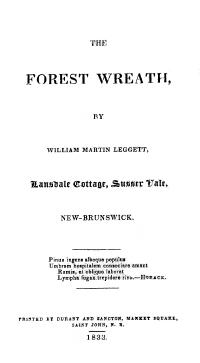William M. Leggett
1808-1878
William Martin Leggett (poet, teacher, and preacher) was born 15 December 1808 in New York. Leggett’s father moved from New York to Sussex Vale, New Brunswick in 1818 to take charge of the Indian School at Sussex Vale. They resided at the Indian Academy, and when it closed in 1826, they taught school from their home, Lansdale Cottage at Sussex Vale. Educated solely under the direction of his parents, he was not known to have received any other formal instruction. At the age of fifteen, he applied for a teaching licence, which was granted on 28 July 1827, making him one of the youngest teachers ever licenced in the province. He taught school at Sussex Vale, in the same district as his parents, for the next six years. Shortly after embarking on his teaching career, Leggett began publishing his poetry. His first poem appeared in the 13 October 1827 issue of The New Brunswick Courier and answered the question “How look’d the pride of the Vale?” In 1830, he submitted a poem to the New Brunswick Courier which had been written “on a Ramble thro’ Sussex Vale to Lansdale Cottage, at Salmon River.” His signature piece, entitled “The Harp of New Brunswick,” first appeared in The City Gazette before being re-printed in his collection of lyrics, The Forest Wreath (1833). Leggett took charge of the Albion Academy at Saint John in 1833 and surrendered his school in 1835 to enter the Methodist ministry. In 1842 he moved to the West Indies to undertake missionary work. When he returned to New Brunswick, he went to the Bathurst Methodist Church, but left the Methodist ministry in 1845 to become an Anglican priest. Throughout the 1830s and 1840s, his poems continued to appear in provincial newspapers. He followed The Forest Wreath with Sacred Poetry (1840). He later moved to London, England where he adopted a new identity, joining the British Army under the name William Alonzo Campbell, and in 1848 was shipped to Sydney, New South Wales, as part of a convict guard. At Bathurst, New South Wales, Leggett wrote verse epics and reminiscences of New Brunswick for the Free Press newspaper as "William M. Leggett, M.A." and in Sydney he wrote newspaper verse as "A Knight Templar XIth Foot". By the early 1850s he had styled himself William Montague Clarence Campbell and by that name (or variants) he was known for the rest of his days. Leggett died at his farm in Runnymede, which he called Lordsland, on 25 April 1878, aged 70.
Vening, Chris. "W.M. Leggett." About AustLit. The University of Queensland, Australia, 26 June 2017. Accessed 9 June 2023
Archival Material
Leggett's missionary correspondence can be found at the Provincial Archives of New Brunswick MC990, New Brunswick and Nova Scotia, 1836–1845, Wesleyan Church Foreign Missions. His correspondence with London from Montserrat and Bermuda, 1843–1844, West Indies Correspondence/FBN 21 and FBN 27 at the SOAS Library, University of London.
There is also correspondence related to Leggett in the New South Wales State Archives: Correspondence, NRS 906, 4/768, Special bundles [Colonial Secretary] and Correspondence, NRS 2621, 1/775 and 1/812 (Eurobodalla) and NRS 2621, 1/853, 1/883, 1/917, 1/951 and 1/976 (Runnymede).

Frontispiece of "The Forest Wreath" by William Martin Leggett
"William Martin Leggett." New Brunswick Literary Encyclopedia, Summer 2009. Accessed 9 June 2023.

See the New Brunswick Literary Encyclopedia entry.